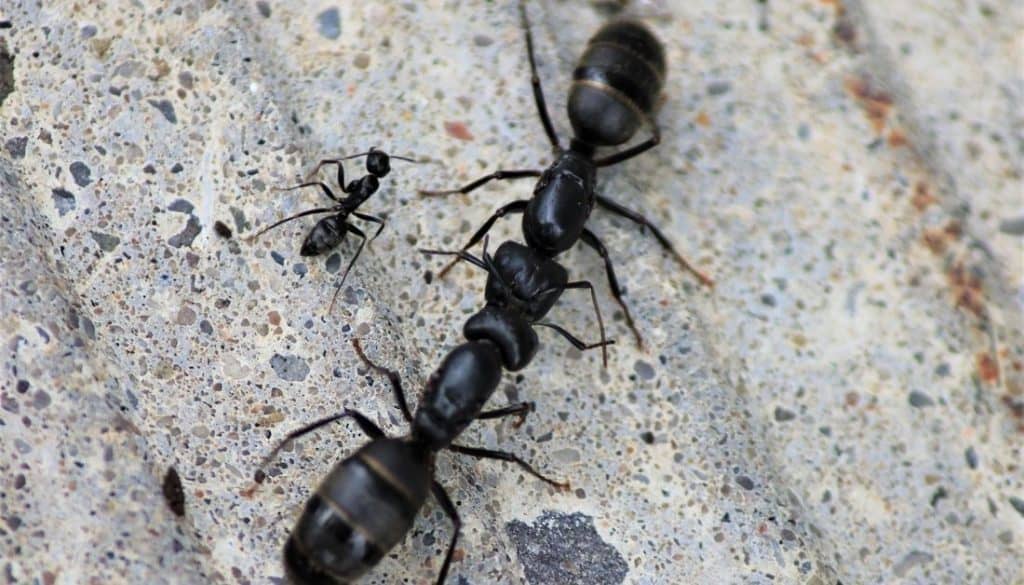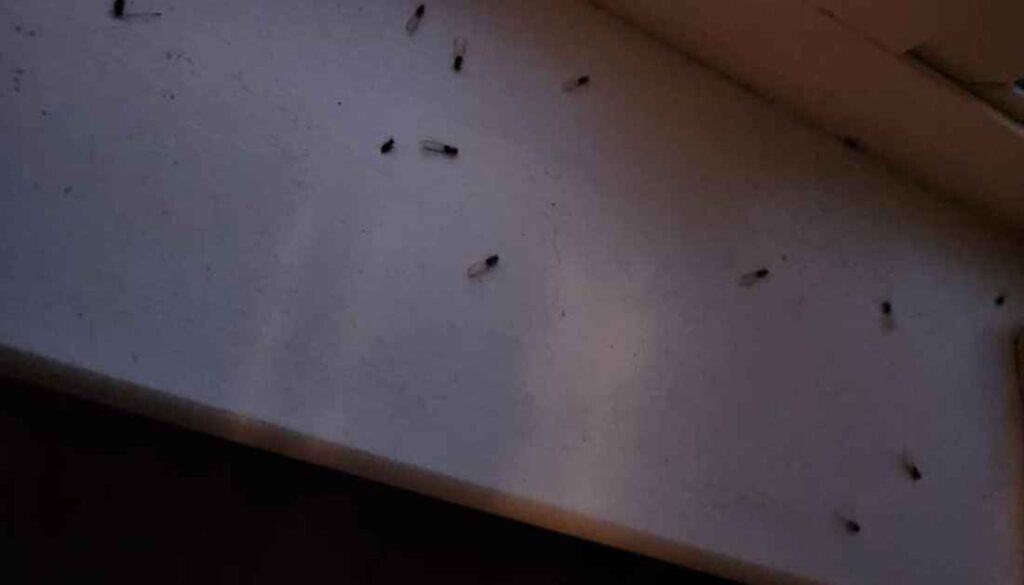You shouldn’t be pleasantly surprised when carpenter ants suddenly disappear, because these ants will eventually reappear.
In fact, most ants that invade homes have a lull their in their activity.
This guide will reveal the reasons for sudden disappearance of ants and why these reasons can trick you into thinking that ants are gone for good.
Let’s dive in.
Depletion In Food Sources
Household ants, including carpenter ants, primarily feed on sugary substances, kitchen wastes, and protein rich foods.
If you’ve given your home and kitchen a thorough cleaning, then you eliminate the food sources that are critical for ants’ survival.
Lack Of Moisture Sources
Carpenter ants are also dependent on moisture to survive.
They live near the damp sources in the house and damp wooden objects such as moist door frames and windowsills are their nesting sites.
When you fix the moisture sources, such as water leaks from pipes and faucets, in your house then your house isn’t a prime real estate for them as it used to be.
Couple it with removal of food sources and you can literally make the ants struggle to survive.
Predatory Pests
Ants aren’t the top of the food chain in the invertebrate world. There are many on top of them.
When your home has ants then they can attract predators. Pests such as spiders and centipedes will hunt these ants down to eat.
And carpenter ants, because of their bigger size, are quite a mouthful option for these predators.
So, ants presence in the house attract their predators that eat them, leading to a decrease in ant numbers.
Pest Control Measures

Have you been using ant sprays, ant baits, or traps? Or did you use natural ant killers like diatomaceous earth or boric acid?
If yes, then the sudden disappearance of carpenter ants, or any other ant species, in the house is normal.
However, remember that using sprays and other types of ant killers can only have a cosmetic effect.
They don’t remove the ant infestation. In fact, the ants retreat to the ant colonies or nests when you use them, only to come back at a later date.
That’s why it’s important to eliminate the source of ants, which are ant’s nest that contain their larvae and eggs, for a successful ant control.
Else, the ant problems remain in the house.
Cleaning Your Yard Or Garden
It’s not just the cleaning of the indoors that can lead to a hiatus in ant activity. The cleaning of outdoors too can have the same effect.
Many home-invading ants, such as carpenter ants or pavement ants, sneak inside the house from your yard or neighboring apartment.
They live in the decaying organic wastes such as mulch beds, moist wood blocks, leaf litter, and tree stumps. Some ants can also live in the dense vegetation and trees of your yard.
It all begins when a random ant enters home scouting for food and nesting site, leaving behind pheromones, for the other ants to follow.
So, when you clean your yard or garden you also disrupt their habitat causing the ants to leave looking for other places to hide.
It’s Winter Time!
When winters arrive, ants hibernate. They retreat back to their colonies, cutting themselves off from the outer world and wait till spring arrives.
Ants’ body temperature falls drastically, triggering a season-long period of inactivity.
That’s why the most sudden disappearance of ants occur in the winter months. They seal themselves off into their colonies underground or wall voids where there nests are.
Natural Death Or Disease
Most ant species, including carpenter ants, are susceptible to diseases and parasites that can lead to the death of entire ant colony.
For example, fungal infections. Certain types of fungi, such as those in the genus Metarhizium and Beauveria, can infect and kill ants.
The spores of these fungi are in the soil and can attach to the ants as they move, eventually penetrating their exoskeleton and consuming them from the inside out.
Microsporidians such as Kneallhazia and Vairimorpha can disrupt the ants’ ability to reproduce and function, leading to a colony’s decline.
Bacteria such as Pseudomonas and Serratia, can infect ants and cause diseases that can wipe out an entire colony.
Phorid flies are infamous for parasitizing on ants. They lay eggs on ants. The hatching larvae burrow into the ants, eating them from inside. That leads to the demise of ants.
All these fungi and bacteria exist in nature that can obliterate entire colony of ants, leading to their sudden disappearance.
Ant Interspecies Competition
Carpenter ants, in fact all ants, are always competing head on with other ant species for food sources and nesting sites.
There are many ants that invade homes. Odorous house ants, pharaoh ants, argentine ants, acrobat ants, and the infamous fire ants all target the same food sources as carpenter ants do.
That can cause the carpenter ants to leave their colonies or they’re decimated because of an all out war with other ants.
Human Activity
Human activity such as home remodeling, landscaping, moving, and shifting can cause ant colonies to move into a more predictable and peaceful location.
Home remodeling and landscaping have the highest impact on ants because these activities can also destroy their nests.
What Do Carpenter Ants Look Like?

House ants such as carpenter ants look like many home-invading ants such as crazy ants, sugar ants etc.
However, knowing that you’re dealing with carpenter ants will help you to eliminate them because you can zero-in on their nesting sites.
Carpenter ants are big black ants that are common in many homes especially during the spring and summer months.
Carpenter ants, when fully mature, are ½ an inch long. They’ve got a prominent head followed by the thorax.
The abdomen is a thick tear-drop shaped rear end of the carpenter ants. There’s a common node that links the thorax and the abdomen.
That node is clearly visible if you notice the carpenter ants closely.
Reasons Why Carpenter Ants Suddenly Appear?
Now that you know why carpenter ants, or all ants in general, suddenly disappear, it’s time to find out why ants suddenly come out of nowhere.
There are many hidden reasons for reappearance of ants. But these 6 reasons are the significant ones.
Ant Swarms

Like all ants, carpenter ants swarm. The swarmers, which are also known as alates, are the reproductive ants with wings.
These winged ants or flying ants leave their current colonies to find a new home to start afresh.
They fly in through the open windows, chasing the light source, such as a glowing light bulb.
They mate, discard their wings, and burrow inside wooden objects or wall voids to start a new colony.
That’s why broken ant wings in the house is a sign of an existing or starting of an infestation.
Ants Invade Homes From The Outdoors
Worker ants sneak inside the house looking for sources of food and nesting. They leave behind their scent trails, which are pheromone chemicals, for other ants to follow.
That’s why you might notice ant trails crawling through the window cracks or wall gaps and entering your home.
Food wastes, poorly stored pet foods, and leaking pipes in the home attract ants.
Termites In The House
Ants eat termites. The worker carpenter ants can easily pick up the termites infesting your home and they’ll follow hunt them down.
Many homes have ant infestation if there’s an existing termite infestation.
Untreated Carpenter Ant Infestation
Carpenter ants in the home and yard can be tough to eliminate if you’re doing it on your own.
These ants have multiple satellite nests catering the main nest where the queen ant reside.
These satellite nests are always in the hard-to-reach areas, such as in the wall voids, or in places like the attic.
Eliminating all the carpenter ants’ nests and killing the queen ant is vital for getting rid of carpenter ant infestation in the house.
And most DIYers fail to do it because they don’t know how to unearth carpenter ant nests.
That’s why it’s best to hire a professional pest control company to remove the ant nests as it’s essential to get rid of the ant problems in the house.
Carpenter Ants Are Back From Hibernation
Many homeowners notice the sudden appearance of ants in the house during the spring and in the warmer days of the year.
The ants that went into hibernation in the winter come back and continue with their feeding and breeding activity.
An exterminator always ensure that they remove the hiding ant colonies in the house to avert the sudden appearance of ants in the house.
Accidental Introduction Of Carpenter Ants In The House
Carpenter ants outdoors hide in the firewood piles and in plant pots. And when you bring these things inside the house, your bring carpenter ants with them.
Carpenter ants will drill into the damp wood of your house to start building their colonies.
That’s why you might notice sawdust below the wooden structures. It’s a sign of either carpenter ants or powder post beetles.
Carpenter ants have a sweet tooth and they’re fond of nectar and honeydew.
Insects such as aphids that feed on plants sap produce honeydew. This honeydew has lots of natural sugar which attract the ants.
Bringing potted plants in the house with honeydew or with ants can also cause a sudden ant infestation in the house right under your nose.
Conclusion
Most ants, including carpenter ants suddenly disappear because of change in weather, scarcity of food, and disruption of their colonies or habitat.
Additionally, parasites, fungi, and bacteria infect ants. They can lead to a surprising lull in ant activity.
However, the sudden disappearance of ants doesn’t mean that your home is free from ant infestation.
As long as their nests are active and they’re hiding in them, ants will come back.
The arrival of ant season, spring and summer, causes a sudden appearance of ants taking homeowners aback.
So, if you’re in the middle of ant removal and you no longer notice ants then don’t stop the treatment. Complete the treatment till you’re sure that you’ve destroyed all ant nests.


